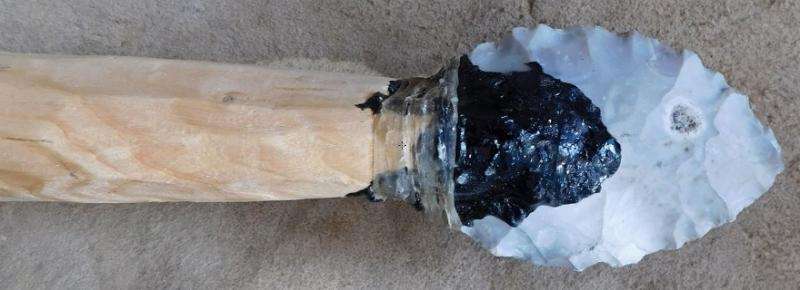How Neanderthals made the very first glue

The world's oldest known glue was made by Neanderthals. But how did they make it 200,000 years ago? Leiden archaeologists have discovered three possible ways. The study is published in Scientific Reports.
A Neanderthal spear is predominantly made up of two parts, a piece of flint for the point, and a stick for the shaft. But one aspect is often overlooked, and has recently been puzzling archaeologists: the glue that fixes the point to the shaft. For this, Neanderthals used tar from birch bark, a material that researchers often assumed was complex and difficult to make.
Leiden archaeologists have now shown that this assumption was unfounded. Led by Paul Kozowyk and Geeske Langejans, the researchers discovered no fewer than three different ways to extract tar from birch bark. For the simplest method, all that is needed is a roll of bark and an open fire. This enabled Neanderthals to produce the first glue as early as 200,000 years ago.
The researchers made this surprising discovery by setting to work with only the tools and materials that Neanderthals possessed. They used experimental archaeology because the preservation of ancient adhesives is incredibly rare and there is no direct archaeological evidence about how tar was made during the Palaeolithic. In situations like this, experimental archaeology provides a window into the past that would not otherwise exist.
'In earlier experimental attempts, researchers only managed to extract small quantities of tar from birch bark, or they didn't get anything at all,' says Kozowyk. 'It was believed that this was because the fire needed to be controlled to within a narrow temperature range. However, we discovered that there are more ways to produce tar, and that some work even with a significant temperature variation. So, precisely controlling the temperature of the fire is not as important as was initially thought.'
Kozowyk and his colleagues show that Neanderthals discovered tar production by combining existing knowledge and materials. Neandertals may have started with a simple method that required only fire and birch bark, and later adopted a more complex method to obtain higher yields of tar.
More information: P. R. B. Kozowyk et al. Experimental methods for the Palaeolithic dry distillation of birch bark: implications for the origin and development of Neandertal adhesive technology, Scientific Reports (2017). DOI: 10.1038/s41598-017-08106-7
Journal information: Scientific Reports
Provided by Leiden University




















